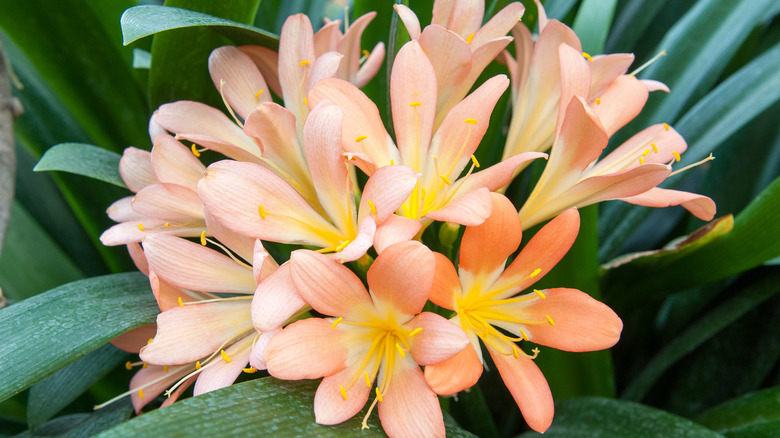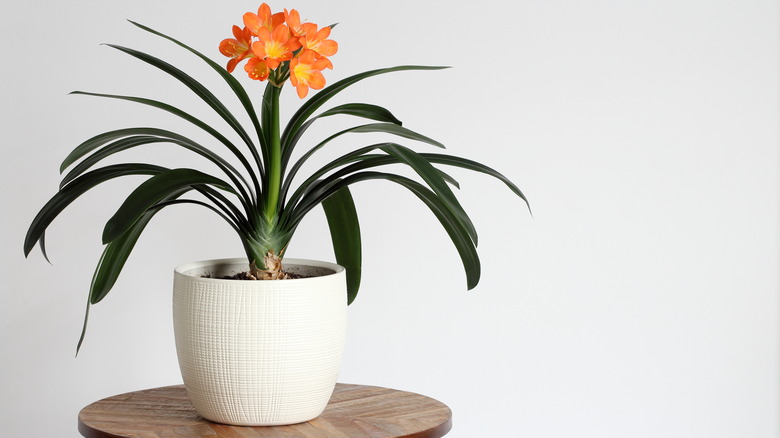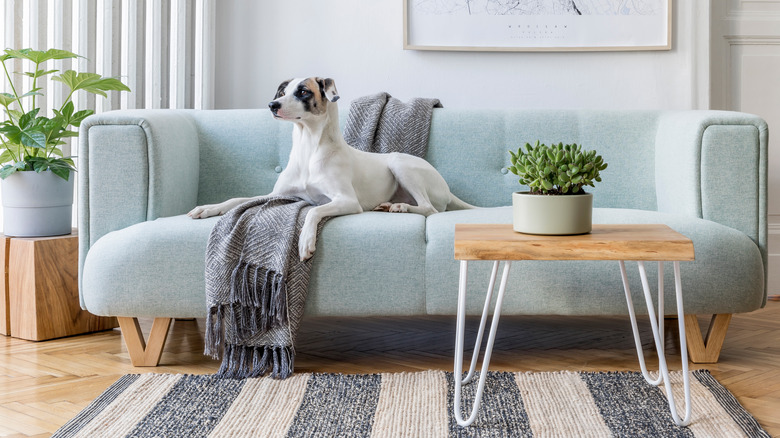Tips For Growing Clivia Plants (And Why Pet Owners Should Avoid It)
Clivias, also called natal lilies, are the perfect blooming plant to brighten up your home. They're low-maintenance, resilient, and full of colorful blooms. Most commonly found in shades of orange and yellow, clivias hail from South Africa and can grow to an impressive 2 to 3 feet in height and width. They're also perennials, which means they'll bloom again and again, producing gorgeous clusters of 12 to 20 flowers on top of a thick stem. And while each flower thrives for just a few days, it'll quickly be replaced by a new one all the way through summer.
Perhaps the best part is how easy clivia plants are to grow. Truly versatile, they thrive in dry climates, grow voraciously in cloudy zones, and do well in sunny locales, too. Clivia likes bright but indirect light in the spring and summer. They can even be taken outdoors, as long as temps are above 36 degrees Fahrenheit and you keep them covered. (Too much sun will scorch their leaves). Come autumn and winter, they should be placed in a cool room through March, with temperatures hovering around 50 degrees Fahrenheit. Unfortunately, the only real downside is they're dangerous for pets. The plant, particularly its bulb, is toxic to both dogs and cats and can cause vomiting, diarrhea, and even cardiac arrhythmia. Here's everything you need to know before purchasing clivias.
Tips for growing beautiful clivia plants
In addition to being fussy about sunlight, clivia plants are also particular about water. You don't want to let them dry out completely, but overwatering is also dangerous, as it can cause root rot. In the fall and winter, only water your plants when you see the foliage starting to wilt. Then, when spring begins, start watering regularly throughout the summer while still allowing your clivias to become dry to the touch between waterings.
The only other maintenance clivia plants need should be done in spring, including replacing the top layer of soil with fresh potting compost and weekly feedings with a liquid fertilizer. What's more, clivias will regularly sprout offsets around their base, which you can detach and plant separately. You'll also want to check if it's time to re-pot your mother plant. Clivias don't like being moved and do well with crowded roots, so they'll only need a new pot every three to five years. If you see the roots are starting to peek through your pot's drainage holes, it's time for a new home. As for pruning, that can wait until fall. Before moving your plant to its cool winter home, remove any faded leaves and cut off the flower stem at its base. And be sure to wear gloves, as a clivia's sap can irritate skin.
How to ensure pets are safe around your plants
Sadly, many popular plants, including lilies, carnations, begonias, and daffodils, are toxic to dogs and cats. On the flip side, there are plenty of beautiful houseplants that are safe for your pets, such as roses, sunflowers, and orchids. Sticking to these is a great way to ensure that your furry friends will be safe, but you can also do a few other things.
To really err on the side of caution, keep your blooms in a place where pets won't have easy access to them. Plant stands and hanging planters can be an excellent way to ensure this, especially with smaller dogs. For bigger pooches or agile cats, you can keep them from getting too close to your plants by spraying the leaves with a mix of water (about 2 ounces) and two drops of citrus, rosemary, or lavender essential oil. This concoction is safe for foliage, but it should work to keep your pets at bay, as they'll dislike the smell and taste and likely stay away. Alternatively, you can place lemon and orange peels directly in the soil to deter your four-legged friends from getting too close.


